본 연구에서는 크리핑 로즈마리(creeping rosemary)의 잎, 가지를 증류수와 70% 에탄올을 용매로 사용해 추출하여 항산화와 미백, 주름, 항염증에 관여하는 효소 저해 활성을 비교하였다. 각각의 ...
http://chineseinput.net/에서 pinyin(병음)방식으로 중국어를 변환할 수 있습니다.
변환된 중국어를 복사하여 사용하시면 됩니다.
- 中文 을 입력하시려면 zhongwen을 입력하시고 space를누르시면됩니다.
- 北京 을 입력하시려면 beijing을 입력하시고 space를 누르시면 됩니다.
https://www.riss.kr/link?id=A109374993
- 저자
- 발행기관
- 학술지명
- 권호사항
-
발행연도
2024
-
작성언어
Korean
- 주제어
-
KDC
594
-
등재정보
SCOPUS,KCI등재
-
자료형태
학술저널
- 발행기관 URL
-
수록면
1030-1039(10쪽)
- DOI식별코드
- 제공처
-
0
상세조회 -
0
다운로드
부가정보
국문 초록 (Abstract)
본 연구에서는 크리핑 로즈마리(creeping rosemary)의 잎, 가지를 증류수와 70% 에탄올을 용매로 사용해 추출하여 항산화와 미백, 주름, 항염증에 관여하는 효소 저해 활성을 비교하였다. 각각의 용매의 최적 추출조건에서 증류수는 23.03mg/g, 70% 에탄올은 29.56 mg/g의 TPC를 함유하는 것으로 나타났다. 항산화 효과를 측정한 결과, 열수와 에탄올 추출물의 DPPH와 ABTS 라디칼 소거 활성은 최대 농도인100 μg/mL에서 83.71%, 90.13% 및 99.90%, 100.50%의 효과를 나타내었다. Antioxidant protection factor의 경우 열수 추출물은 1.30~1.83 값을 나타내었고, 에탄올 추출물은 1.60~1.84로 우수한 PF값을 나타내었다. TBARs의 경우 열수와 에탄올 추출물 모두 최고 농도에서 90%에 근접한 값을 확인하였다. 크리핑 로즈마리 추출물의 tyrosinase 저해 효과는 400 μg/mL에서 38.86%로 에탄올 추출물의 미백활성이 우수한 것으로 확인되었다. 주름 개선 효과와 관련된elastase와 collagenase 저해 활성은 열수와 에탄올 추출물의 400 μg/mL에서 각각 22.59%, 38.87% 및 45.38%, 29.59%의 효과를 나타내 주름 개선 효과가 우수한 것으로 확인되었다. 모공의 수렴작용에 관여하는 astringent는 70% 에탄올 추출물에서 13.14%의 효과가 나타났다. 항염증에 관련된 hyaluronidase 저해 효과는 50~400 μg/mL의 물과 에탄올 추출물에서 각각 19.27~100.56%, 10.71~59.59%의 활성을 보여 열수 추출물의 항염증 효과가 매우 뛰어남을 확인하였다. SVR 기법의 예측모델을 활용하여 생리활성을 위한 최적조건을 탐색한 결과, DPPH, ABTS, PF의 최적 저해농도는 100 μg이며, TBARs 저해 최적농도는 70 μg인 것으로 예측되었다. Tyrosinase와 elastase 저해를 위한 최적농도는 각각 400 μg과 200 μg인 것으로 예측되었다. Collagenase와hyaluronidase 저해를 위한 최적농도는 물 추출물의 경우 각각 320 μg과 200 μg이며, 에탄올 추출물의 경우 두 효소 모두 400 μg 정도로 예측되었다. 또한 수렴효과 발현을 위한 최적 농도는 400 μg으로 예측되었다. 위의 결과에 따르면 크리핑 로즈마리 열수 추출물은 특히 항염증, 주름저해 활성이 있으며, 에탄올 추출물의 경우 미백, 수렴작용, 주름 저해 효과가 우수하게 나타나 크리핑 로즈마리의 추출물은 기능성 화장품 원료 및 미용 식품 소재로의 활용이 가능할 것으로 기대되었다.
다국어 초록 (Multilingual Abstract)
In this study, antioxidant, whitening, anti-wrinkle, and pore contraction properties were analyzed. The total phenolic contents of creeping rosemary (CR) under optimal extraction conditions in water extract (CRWE) and 70% ethanol extract (CREE) were 2...
In this study, antioxidant, whitening, anti-wrinkle, and pore contraction properties were analyzed. The total phenolic contents of creeping rosemary (CR) under optimal extraction conditions in water extract (CRWE) and 70% ethanol extract (CREE) were 23.03 mg/g and 29.56 mg/g, respectively. DPPH and ABTS free radical scavenging activities of CRWE and CREE were approximately 83% and 99% at 100 μg/g, respectively. Moreover, the antioxidant protection factor of CRWE and CREE was 1.83 and 1.84 at 100 μg/g, respectively. CRWE was shown 100% hyaluronidase inhibition, 45.38% collagenase inhibition as anti-inflammation and wrinkle improvement properties. CREE exerted higher inhibitory activities about tyrosinase, collagenase, elastase, hyaluronidase, astringent effect on 38.86%, 29.59%, 38.87%, 59.59%, and 14.14%, respectively. Using the support vector regression statistics model to predict optimal conditions for biological activity, the optimal inhibitory concentrations for DPPH, ABTS, and antioxidant protection factor were predicted to be 100 μg and TBARs was predicted to be 70 μg. The optimal inhibitory concentrations of tyrosinase and elastase were predicted to be 400 μg and 200 μg, respectively. For collagenase and hyaluronidase inhibition, the optimal concentrations were predicted to be 320 μg and 200 μg for CRWE and 400 μg of both enzymes for CREE, respectively. In addition, the optimal concentration for the astringent effect was predicted to be 400 μg. These results indicated the antioxidant, whitening, pore-tightening, and anti-wrinkle properties of CR extracts, which have potential use as ingredients for cosmetics.
동일학술지(권/호) 다른 논문
-
HepG2 인체 간암 세포에서 식물성 플라보노이드인 7,8-Dihydroxyflavone에 의한 세포사멸 유도
- 한국식품영양과학회
- 황보현(Hyun Hwangbo)
- 2024
- SCOPUS,KCI등재
-
식품산업에의 활용을 위한 콩과 녹두의 일차 가공적성 평가
- 한국식품영양과학회
- 오서영(Seo Young Oh)
- 2024
- SCOPUS,KCI등재
-
- 한국식품영양과학회
- 김윤혜(Yun-Hye Kim)
- 2024
- SCOPUS,KCI등재
-
연근 분말을 첨가하여 제조한 수프의 품질특성 및 항산화 활성
- 한국식품영양과학회
- 황은선(Eun-Sun Hwang)
- 2024
- SCOPUS,KCI등재






 DBpia
DBpia






